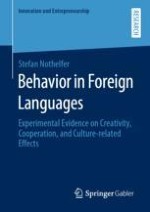2020 | OriginalPaper | Buchkapitel
3. Foreign Language Effects on Creativity
verfasst von : Stefan Nothelfer
Erschienen in: Behavior in Foreign Languages
Verlag: Springer Fachmedien Wiesbaden
Aktivieren Sie unsere intelligente Suche, um passende Fachinhalte oder Patente zu finden.
Wählen Sie Textabschnitte aus um mit Künstlicher Intelligenz passenden Patente zu finden. powered by
Markieren Sie Textabschnitte, um KI-gestützt weitere passende Inhalte zu finden. powered by
